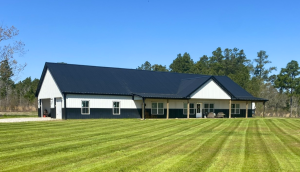Preventing Radon Issues in Slab-On-Grade Barndominiums
I grew up in what is now Spokane Valley, Washington. Little did any of us know, back then, it turns out Spokane County is one of six counties in Washington State requiring radon mitigation measures in newly-constructed residences and residential additions. Radon is a natural in ground radioactive gas. It comes from decay or breakdown of uranium, a radioactive element in rocks and soil. Radon has no odor, color, or taste. Radon is the leading cause of lung cancer among nonsmokers.
Wonderful….not.
Building your new post frame home or barndominium in a radon sensitive area? There are some precautions to take to mitigate possible effects.
Passive radon mitigation systems can save lives. When properly installed, passive radon mitigation systems can keep radon levels down without radon fan. New barndominiums can be built radon resistant with a permanently installed passive radon system.
Although codes vary from town to town, there are six basic components of radon resistant new construction techniques:
Install a gas permeable layer before concrete slab is poured. This is usually a six inch layer of clean gravel. Gravel is very porous and allows for simple air movement below concrete slab. This will help your passive radon system move radon and other soil gas without restriction.
Install a vapor barrier above gas permeable layer before concrete slab is poured. A minimum 6mil plastic membrane is recommended (and Building Code required minimum for under slabs in conditioned buildings). Vapor barrier seams should be overlapped by at least 12″ and taped with high grade vinyl tape. My recommendation is a 15mil true vapor barrier, far superior (less prone to puncture) than 6mil visqueen.
install radon collection point with schedule #40 PVC pipe stub. Concrete will be poured around this pipe stub. It is extremely important to create a radon collection point unimpaired when concrete is poured. This is usually done by installing a soil gas collection pipe (drain-tile) or PVC tee.
Seal and caulk radon entry points. It is important to seal all visible concrete floor cracks, control joints and cold joints (where any foundation meets floor) using proper concrete caulk. If your home has a sump, it is a primary radon entry point and should be sealed air tight with a proper sump cover. Sump cover should be removable in case sump needs to be worked on. Plumbing roughs are another radon entry point and should be sealed with a cover. Once plumbing work is complete it is important to seal around pipes with concrete or expandable foam sealant.
Install radon vent pipe. When installing a passive radon system, it is important to install a radon vent pipe through an interior wall or flue chase. As your home warms this pipe, a natural stack effect will occur to pull air through the pipe; this in-turn pulls radon gas out of the soil. It is best practice to use 4″ PVC in radon resistant new construction to allow for maximum CFM in the event the system is activated. Radon suction pipe should continue through interior walls to attic space above home or building in a location allowing for future access. Vent stack should terminate through the roof at least ten feet from windows, doors or other building openings.
Install a electrical junction box within reachable distance of in attic radon vent pipe in attic. This will allow for an electrical source in the event the system is activated.
You may want to engage a radon mitigation contractor when using radon resistant new construction techniques. Radon contractors know how to properly move below building air. In many areas, plumbers are used to install passive radon systems. Often it is found that the suction point is placed in gravel and concrete has created a seal around the radon suction point location. This is dangerous because the new barndominium owner believes their home is built radon resistant yet passive radon pipe cannot move any air. If you have a home with a passive system, be certain to perform a radon test at least every two years.
If radon levels remain elevated after radon resistant techniques have been used, this passive radon system can easily be converted to an active soil depressurization system (active radon system). This can be done by adding a radon fan to the radon vent pipe in your attic space above.






